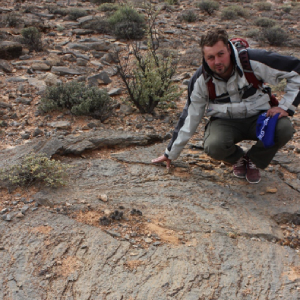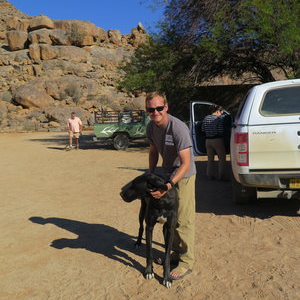By Andy Flick, Evolutionary Studies Initiative scientific coordinator
Knowing how life worked on Earth 550 million years ago can give perspective on how life could evolve on other planets. Geobiologist and Assistant Professor of Earth and Environmental Sciences Simon Darroch and postdoctoral researcher Brandt Gibson are working to figure that out.
“At the broadest scale, understanding how, when, and why complex life evolved on this planet gives us a sense for how likely it is that we’ll find complex life elsewhere in the solar system, and what it may look like,” Darroch said. “I honestly can’t think of anything cooler to be working on.”

Their research features strange, vase-like organisms (in the genus Ernietta) that lived in the Ediacaran era—approximately 635 million to 541 million years ago. These organisms lived in marine environments, where fluid dynamics drive the evolution of the organisms that inhabit them.
This work brought two distinct areas of science together—paleontology and fluid dynamics, which describes the flow of liquids and gases. “Paleontology is at its most exciting—and arguably most successful—when it works at the interface with other disciplines. In this case, it’s fluid physics,” Darroch said.
Computer models of fluid dynamics that affect communities of organisms suggest that when isolated, larger individuals have better nutrient circulation in their body cavities than smaller individuals. However, when different sizes of individuals live together, larger ones can create beneficial conditions for smaller ones that are downstream. Gibson led this research, conducted within the Evolutionary Studies Initiative, which resulted in an article published by Frontiers in Earth Science on Oct. 18.
Throughout Gibson’s graduate studies in Darroch’s lab, the two participated in the Blended and Online Learning Design Fellows Program. The BOLD Program enables graduate student and faculty teams to develop online instructional materials grounded in solid course design principles and an understanding of how people learn. “I’m sure some of our discussions in generating those materials helped spark ideas presented in this research,” Gibson said.
“The same ecological tricks that allow organisms to feed, move and reproduce have evolved again and again through time, likely because life in moving fluids exerts such strong selective pressure. Ernietta in particular seem to behave a lot like some gregarious mussel groups, especially beds of mussels and oysters,” Darroch explained.

“Perhaps the greatest benefit is that smaller Ernietta would be protected from adverse flow when downstream of larger ones, but they also consistently receive stronger cavity recirculation (probably aids in suspension feeding),” Gibson said. “Our simulations suggest that these sorts of ecological dynamics, which are well-known in living animals, also helped to structure Ediacaran communities composed of organisms that are entirely mysterious to us.”
Darroch praised the lab’s efforts in spearheading this research: “It took talented students like Gibson to actually get this effort going, and he’s been expanding the lab’s horizons ever since.”
These new horizons are already approaching in the capable hands of Andrei Olaru and Hale Masaki, undergraduate students in biological sciences and EES, respectively. “Andrei and Hale are using similar techniques to help understand some other mysterious Ediacaran taxa,” Darroch said. The students recently earned trainee travel grants through the ESI to present their work at the annual meeting of the Paleontological Society in Oxford, England.
“We’re working with a very talented team at Oxford, and together we’ve reconstructed whole surfaces from Mistaken Point in Newfoundland, Canada. Looking at how these broader-scale flow regimes evolve through the Ediacaran-Cambrian boundary will give us vital clues as to how facets of biology and ecology were changing throughout that time period,” Darroch said.

